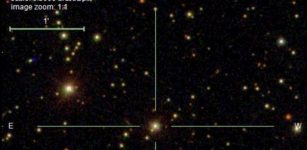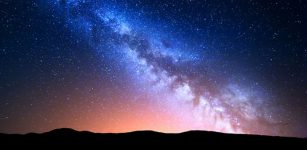Surprising Activity Of Supermassive Black Hole At The Center Of Milky Way
Eddie Gonzales Jr. – MessageToEagle.com – The enormous black hole at the center of our galaxy is having an unusually large meal of interstellar gas and dust, and researchers don’t yet understand why.
“We have never seen anything like this in the 24 years we have studied the supermassive black hole,” said Andrea Ghez, UCLA professor of physics and astronomy and a co-senior author of the research, said in a press release.
 Rendering of a star called S0-2 orbiting the supermassive black hole at the center of the Milky Way. It did not fall in, but its close approach could be one reason for the black hole’s growing appetite. Nicolle Fuller/National Science Foundation
Rendering of a star called S0-2 orbiting the supermassive black hole at the center of the Milky Way. It did not fall in, but its close approach could be one reason for the black hole’s growing appetite. Nicolle Fuller/National Science Foundation
“It’s usually a pretty quiet, wimpy black hole on a diet. We don’t know what is driving this big feast.”
The researchers analyzed more than 13,000 observations of the black hole from 133 nights since 2003, obtained by the W.M. Keck Observatory in Hawaii and the European Southern Observatory’s Very Large Telescope in Chile.
The team found that on May 13, the area just outside the black hole’s “point of no return” (so-called because once matter enters, it can never escape) was twice as bright as the next-brightest observation.
They also observed large changes on two other nights this year; all three of those changes were “unprecedented,” Ghez said.
The brightness the scientists observed is caused by radiation from gas and dust falling into the black hole; the findings prompted them to ask whether this was an extraordinary singular event or a precursor to significantly increased activity.
“The big question is whether the black hole is entering a new phase — for example if the spigot has been turned up and the rate of gas falling down the black hole ‘drain’ has increased for an extended period — or whether we have just seen the fireworks from a few unusual blobs of gas falling in,” said Mark Morris, UCLA professor of physics and astronomy and the paper’s co-senior author.
The team has continued to observe the area and will try to settle that question based on what they see from new images.
“We want to know how black holes grow and affect the evolution of galaxies and the universe,” said Ghez, UCLA’s Lauren B. Leichtman and Arthur E. Levine Professor of Astrophysics. “We want to know why the supermassive hole gets brighter and how it gets brighter.”
Written by Eddie Gonzales Jr. – MessageToEagle.com Staff










